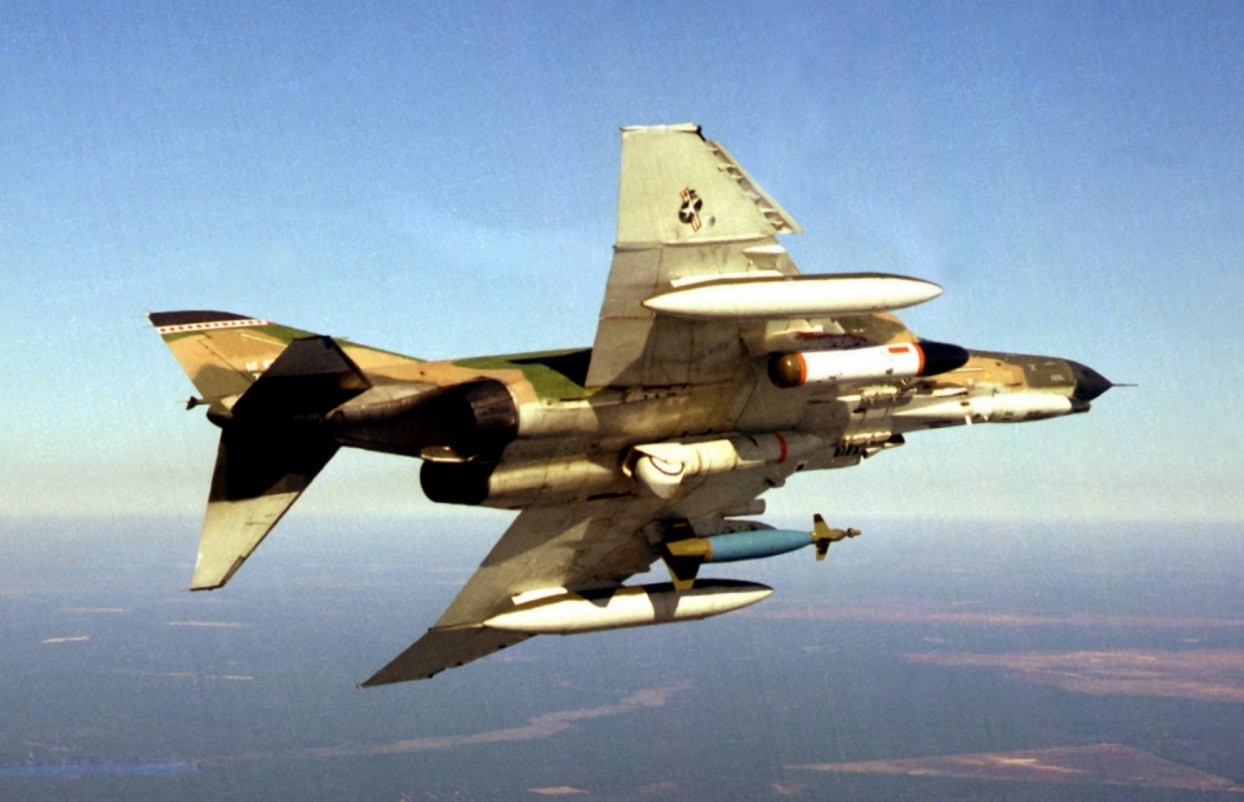The F-4 Phantom was a mainstay of the U.S. Navy for a long time, however, her days flying for the stars and stripes are long since passed. However, and oddly enough, Iran flies them – a mortal U.S. enemy. Why? Nicknamed the “Flying Anvil”, the F-4 Phantom II twin-engine, tandem seat supersonic jet interceptor saw extensive service in Vietnam as a strike fighter platform. The Navy, Marine Corps, and Air Force all utilized the third-generation jet fighter since the onset of its entry into service in the 1960s. The McDonnell Douglas platform established 16-speed, altitude, and time-to-time climb records, making it one of the most versatile aircraft of its time. Weighing it at nearly 30,000 pounds unloaded, the F-4’s heavy frame could carry thousands more pounds of munitions than its predecessors.
F-4 Multirole in the Air
The Phantom II performed four crucial roles during the time of its conception, including interdiction, air superiority, close-air support, and fleet defense. However, the platform’s lack of a built-in cannon and reliance on subpar newly-introduced missiles clouded its track record in the Vietnam War.
In the 1970s, improvements helped elevate the Phantom’s lethality across each military branch. The Air Force improved its fleet’s maneuverability by upgrading wing slats, and the Navy established the Top Gun training program to promote air combat training. Over 5,000 F-4 platforms were delivered throughout its lifespan in the U.S., and their subvariants are still being used today.
Unlike the F-14 Tomcat, whose sole foreign customer was Iran, the Phantom II was distributed around the world. Israel’s success in the 1973 Yom Kippur War could in part be attributed to the platform’s capabilities. In the same time period, the U.S. granted Iran 225 Phantoms with the intention of garnering anti-Soviet support in the region. However, similar to the F-14 Tomcat’s history, the Phantom II shifted into adversarial hands post-Iranian Revolution in 1979.
F-4 Continued Upgrades
While the U.S. ceased distributing the F-4 platform to Iran after the fall of the Pahlavi Dynasty, its Air Force has been able to maintain and even advance the fighter jets through modifications and newly formed defense partners. In November 2020, Iran showcased its Qased 900kg electro-optic-guided smart bombs in its annual “Defenders of the Sky” drills. The regime’s ability to potentially strike targets with significantly greater precision poses a threat to the region.
According to the Defense Intelligence Agency, Iran’s current F-4 fleet should alarm its adversaries. “To supplement its long-range strike capabilities, Iran could also attempt to use its regional proxies and limited airstrike capability to attack an adversary’s critical infrastructure. Iran maintains an aging inventory of combat aircraft—such as decades-old U.S. F-4 Phantoms— which it could attempt to use to attack its regional adversaries. However, these older platforms would be more vulnerable to air defenses than modern combat aircraft.”
Although the F-4 platform is aging, the fighter jets can successfully outperform counterparts across the region. Iran’s acquisition of advanced air-launched anti-ship missile systems is a threat. These armaments from U.S. adversaries, including China, continue to help elevate the mission set of their F-4 fleet to an armed maritime strike role. For example, Iran’s Nasr anti-ship cruise missile is a variant of the People’s Liberation Army’s C-704. The Iranian Air Force has also manufactured its own native-grown medium-range cruise missiles to launch from the F-4.
Combined with its F-14 and MiG-29 fighter squadrons, Iran’s Phantom fleet remains the backbone of its Air Force. This Vietnam-era platform should not be underestimated.
Maya Carlin, now a 1945 Middle East Editor, is an analyst with the Center for Security Policy and a former Anna Sobol Levy Fellow at IDC Herzliya in Israel. She has by-lines in many publications, including The National Interest, Jerusalem Post, and Times of Israel.

